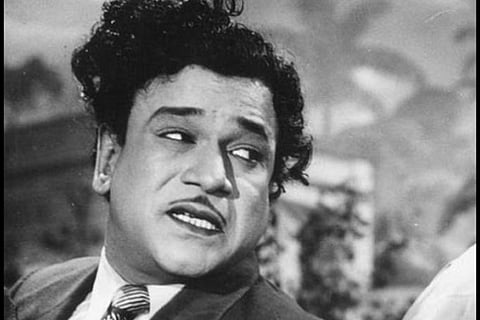

Chennai
Very few actors would dare to act as a leper on the screen fearing that sickly image would stick on endlessly. Challenging that, ‘Madras’ Rajagopala Radhakrishnan (M in his initial stands for Madras!) would make the film Ratha Kanneer (tears of blood) as the epitome of his career. He was known as MR Radha popularly and given the title Nadiga Vel — the king of actors.
Radhakrishnan was born in one of the oldest localities of Modern Madras — Chintadripet and lived with his widowed mother. His father, a soldier, had died in the World War on the Eurasian front. Radha ran away from home at the age of seven and joined a theatre group. Ironically, the first role a lifelong-atheist Radha would play was that of Krishna killing Bhoothaki.
Starting from Madurai Bala Meena Ranjani Sangeetha Sabha, highly individualistic Radha was indeed a thorn wherever he went. His freestyle acting was quite obtrusive on any group’s discipline. He would ride a motorcycle on a drama stage on which other actors respectfully would not even wear footwear.
time progressed, Radha was getting bigger roles and his mannerisms were being noted. Once during a drama visit to Erode, he visited EV Ramasamy Naicker and was convinced on his self-respect philosophy. He would become a lifetime follower even when those who were considered Periyar’s closest would water down their principles for political survival.
Radha was an early entrant to the cinema (1937) but was injured in a risky shot on his debut. However, gutsy Radha, after exposure to a single film, would borrow money and try to make his talkie. This bankrupted him. The two events in quick succession kept him away from films for nearly two decades.
Soon, Radha developed a fan base of his own and would even make up his own dialogue according to current events. The so-called newspaper scene in every drama was famous. Every morning he would ask someone to read aloud a newspaper, his reading skills being in serious doubt. Then with some creative thinking, he would decide on the dialogue which would be a stinging rebuke on some current event. Radha, never shying away from controversies, even made a play in which he played the role of the murdered blackmailer Lakshmikanthan.
Soon he was drawn into DK politics and his plays became important components of Kazhagam conferences. Poet Bharathidasan would once introduce him to the audience as “one of our own”. Even the British looked to him for war propaganda theatre. One of the earliest plays of M Karunanidhi, Thooku Medai (the gallow stage) was written for Radha. MK acted as a student leader in the same play and the popular prefix Kalaignar was given on the stage along with the first day’s gate collection.
In 1949, when Radha would create his masterpiece Ratha Kanneer. His family was superstitious about him playing a leper and was afraid that it would bring bad luck and disease.
He played Mohan, a foreign-returned anglophile who contracts the deadly leprosy disease due to his womanising (perhaps what the dramatist wanted was a venereal disease but leprosy was more dramatically visible as symptoms) and is shunned by the society whose embrace he longed for. It was easier said than done. The intermission was a hectic time in the green room where a hat-and-suit wearing Radha was quickly changed to tatters with a deformed face of leprous beggar.
The play was a runaway hit and though staged 5,000 times no two versions were alike. ‘Adiye kantha’ became a famous dialogue across the Presidency. The play was very popular amongst women for it reportedly had a dramatic impact on lowering male philandering in society.
Producers knew that if made into a film with Radha as a hero it would be a gold mine. But most were afraid to approach him fearing his caustic retorts. PA Perumal decided to bell the cat. Radha’s conditions were accepted. He would act only at night after his drama show was over. He also wanted Rs 1.25 lakh as fees, Rs 25,000 more than KB Sundarambal’s record fee in a Gemini film.
The success of Ratha Kanneer drew him into movies and most of his film tracks were specially written for him. There were a lot of spoofs. In one he was a barber who is discovered to be the real heir to a zamindar leading to hilarious situations. He acted in 100 films in character, comedy and villain roles mostly challenging the established social norms.
Meanwhile, on stage, his spoof on Ramayana entitled Keemayanam, caused a great deal of unrest. The Tamil Nadu Dramatic Performance Act, 1954 was brought into force to control scripts like his. Many of his plays were banned but Radha went from town to town delighting the now weakened DK. He would announce one play and after the first customary scene would shift to the banned script. He was hauled to court many times.
But what MR Radha is remembered for and what happens to be the biggest puzzle of cinemadom was his shooting of MGR and his subsequent suicide attempt. Both survived but while Radha went to jail, MGR romped to the legislature with a thumping majority in the following election.
After serving a long prison term for the shooting, Radha was rearrested during the Emergency as well and this finished the little vitality he had. Radha is remembered today mainly for his pungent dramatics which was mostly harsh criticism of social mores.
— The author is a historian
Visit news.dtnext.in to explore our interactive epaper!
Download the DT Next app for more exciting features!
Click here for iOS
Click here for Android